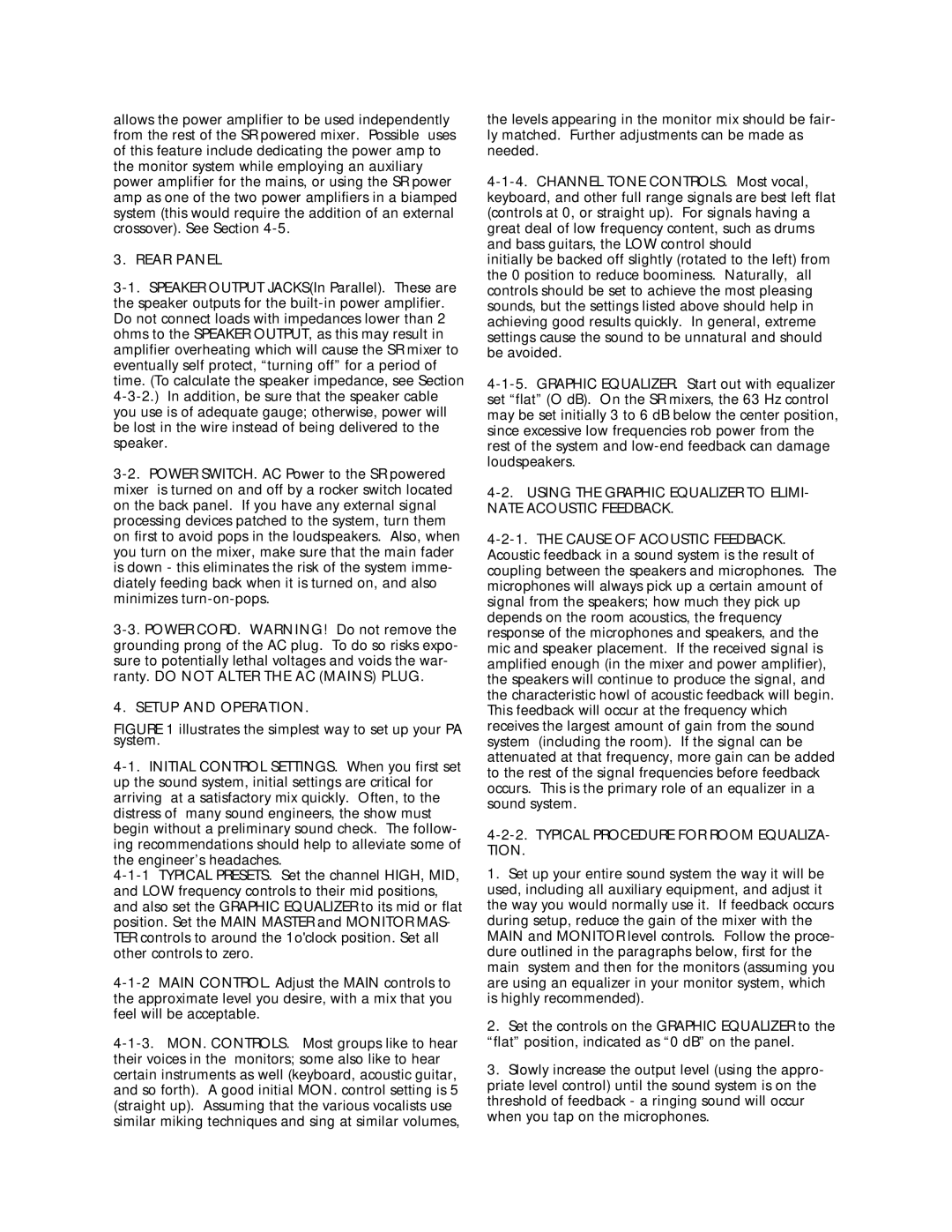allows the power amplifier to be used independently from the rest of the SR powered mixer. Possible uses of this feature include dedicating the power amp to the monitor system while employing an auxiliary power amplifier for the mains, or using the SR power amp as one of the two power amplifiers in a biamped system (this would require the addition of an external crossover). See Section 4-5.
3. REAR PANEL
3-1. SPEAKER OUTPUT JACKS(In Parallel). These are the speaker outputs for the built-in power amplifier. Do not connect loads with impedances lower than 2 ohms to the SPEAKER OUTPUT, as this may result in amplifier overheating which will cause the SR mixer to eventually self protect, “turning off” for a period of time. (To calculate the speaker impedance, see Section 4-3-2.) In addition, be sure that the speaker cable you use is of adequate gauge; otherwise, power will be lost in the wire instead of being delivered to the speaker.
3-2. POWER SWITCH. AC Power to the SR powered mixer is turned on and off by a rocker switch located on the back panel. If you have any external signal processing devices patched to the system, turn them on first to avoid pops in the loudspeakers. Also, when you turn on the mixer, make sure that the main fader is down - this eliminates the risk of the system imme- diately feeding back when it is turned on, and also minimizes turn-on-pops.
3-3. POWER CORD. WARNING! Do not remove the grounding prong of the AC plug. To do so risks expo- sure to potentially lethal voltages and voids the war- ranty. DO NOT ALTER THE AC (MAINS) PLUG.
4. SETUP AND OPERATION.
FIGURE 1 illustrates the simplest way to set up your PA system.
4-1. INITIAL CONTROL SETTINGS. When you first set up the sound system, initial settings are critical for arriving at a satisfactory mix quickly. Often, to the distress of many sound engineers, the show must begin without a preliminary sound check. The follow- ing recommendations should help to alleviate some of the engineer’s headaches.
4-1-1 TYPICAL PRESETS. Set the channel HIGH, MID, and LOW frequency controls to their mid positions, and also set the GRAPHIC EQUALIZER to its mid or flat position. Set the MAIN MASTER and MONITOR MAS- TER controls to around the 1o'clock position. Set all other controls to zero.
4-1-2 MAIN CONTROL. Adjust the MAIN controls to the approximate level you desire, with a mix that you feel will be acceptable.
4-1-3. MON. CONTROLS. Most groups like to hear their voices in the monitors; some also like to hear certain instruments as well (keyboard, acoustic guitar, and so forth). A good initial MON. control setting is 5 (straight up). Assuming that the various vocalists use similar miking techniques and sing at similar volumes,
the levels appearing in the monitor mix should be fair- ly matched. Further adjustments can be made as needed.
4-1-4. CHANNEL TONE CONTROLS. Most vocal, keyboard, and other full range signals are best left flat (controls at 0, or straight up). For signals having a great deal of low frequency content, such as drums and bass guitars, the LOW control should
initially be backed off slightly (rotated to the left) from the 0 position to reduce boominess. Naturally, all controls should be set to achieve the most pleasing sounds, but the settings listed above should help in achieving good results quickly. In general, extreme settings cause the sound to be unnatural and should be avoided.
4-1-5. GRAPHIC EQUALIZER. Start out with equalizer set “flat” (O dB). On the SR mixers, the 63 Hz control may be set initially 3 to 6 dB below the center position, since excessive low frequencies rob power from the rest of the system and low-end feedback can damage loudspeakers.
4-2. USING THE GRAPHIC EQUALIZER TO ELIMI- NATE ACOUSTIC FEEDBACK.
4-2-1. THE CAUSE OF ACOUSTIC FEEDBACK. Acoustic feedback in a sound system is the result of coupling between the speakers and microphones. The microphones will always pick up a certain amount of signal from the speakers; how much they pick up depends on the room acoustics, the frequency response of the microphones and speakers, and the mic and speaker placement. If the received signal is amplified enough (in the mixer and power amplifier), the speakers will continue to produce the signal, and the characteristic howl of acoustic feedback will begin. This feedback will occur at the frequency which receives the largest amount of gain from the sound system (including the room). If the signal can be attenuated at that frequency, more gain can be added to the rest of the signal frequencies before feedback occurs. This is the primary role of an equalizer in a sound system.
4-2-2. TYPICAL PROCEDURE FOR ROOM EQUALIZA- TION.
1.Set up your entire sound system the way it will be used, including all auxiliary equipment, and adjust it the way you would normally use it. If feedback occurs during setup, reduce the gain of the mixer with the MAIN and MONITOR level controls. Follow the proce- dure outlined in the paragraphs below, first for the main system and then for the monitors (assuming you are using an equalizer in your monitor system, which is highly recommended).
2.Set the controls on the GRAPHIC EQUALIZER to the “flat” position, indicated as “0 dB” on the panel.
3.Slowly increase the output level (using the appro- priate level control) until the sound system is on the threshold of feedback - a ringing sound will occur when you tap on the microphones.
